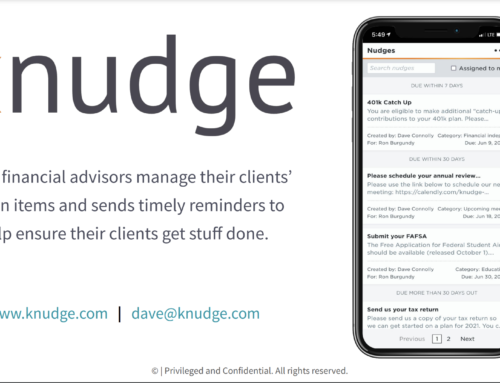As a financial planner, we know that there are a lot of potential barriers to our clients taking the steps required to get (and keep) their financial lives in order
In this guest post, Emily Shull, a Certified Money Coach from Me, Myself and Money addresses some of the emotional barriers we all struggle with in making changes and provides us with tips on how to help address those.
It is part of our job as advisors to facilitate conversations around the emotional barriers Emily outlines below. It’s also important for us to recognize that sometimes our clients just aren’t ready for all the changes we may want them to make, so we need to hear them and focus on the steps they are ready to take.
Once your clients have committed to making changes, Knudge is here to handle the administrative side of making sure all the doing gets done. This way, instead of spending your important time with clients chasing them down “sign this form”, “pay that bill”, or “send us this data”, you can focus that time on the right conversations; helping them make great financial decisions while identifying and addressing the emotional barriers that may prevent them from taking action.
-Shaun Erickson
How to Take the Dread Out of Your To-Do List
We all have one. A list of dreaded administration tasks that are no fun, but must be done. What’s on yours? Making a will? Rolling over a 401K? Breaking up with the bank you’ve long hated?
We will never approach these tasks with enthusiasm, but there’s good news. There are simple strategies that can help us complete tasks with less stress so we can reap their benefits and then turn our attention elsewhere.
Get it done in minutes.
A few minutes at a time, that is. We often postpone tasks because we dread spending time on something boring and potentially complicated
That is why breaking it into micro-tasks works so well. The smaller the better. This ensures that no one step feels overwhelming. Schedule a few minutes a day in your calendar for each specific task. By the end of the week, you’ll have one less thing occupying your precious headspace.
Example: Rollover old 401k
Day 1: Look up the contact information for the plan (or for the employer if you can’t find the plan).
Day 2: Make the phone call or send an email.
Day 3: Download the form they send you and fill out the easy stuff.
Day 4: Call or dig into your files to answer the questions that require further explanation or research.
Day 5: Sign and put in the mail. Treat yourself to your favorite takeout as a reward.
I followed these steps recently for an insurance claim I’d been putting off. I couldn’t believe how quick and painless it was.
But I don’t want to do this!
Sometimes our best intentions and plans fail. We ignore our own appointment reminders, ruminating in the thought, “I don’t want to do this!”
When this happens to you, it’s time to dive deeper. Have a conversation with yourself and ask what, exactly, is stopping you. It’s usually an emotion. And that emotion, once recognized, will set you free.
When I asked myself why I was procrastinating on filing my insurance claim, the answer came right away. I was embarrassed. One month had passed since the incident. I was embarrassed that I hadn’t handled it sooner. And the longer I waited, the more ashamed I felt. I also felt a tinge of fear. What if it was too late to file a claim?
Acknowledging emotions is key to moving forward. This is because we cannot make rational decisions when we are stuck in an emotional response. Emotions and decisions originate from different parts of the brain, and they cannot occur simultaneously.
Luckily, there is an easy way to switch from our emotional brain to our rational brain. Name it to tame it. Psychiatrist Dan Siegel coined this phrase as an easy reminder. When you find yourself upset, overwhelmed, stuck or out of control, ask yourself, “What am I feeling?” Then answer.
The act of asking questions takes us out of the emotional center of our brain and into the thinking center. Once we’re there, we can make rational decisions.
After asking yourself what you are feeling, follow up with this series of questions. It will bring you to the point of action
“What is the worst that can happen?”
“What is the best possible outcome?”
“Is it worth it to move forward?”
When I realized embarrassment was holding me back from filling the insurance claim, I asked myself, “What’s the worst that can happen?” The banality of the answer surprised me. I could feel embarrassed when talking to the claims agent, and they could tell me that it’s too late. Period.
Then I asked, “What’s the best possible outcome?” I could get a full reimbursement of my insurance claim. “Is that worth it?” Yes! And so I immediately contacted my insurance agent to begin the claims process.
The next time you’re struggling with a task, try one or both of these strategies. You’ll be finished and relieved before you know it.

Emily Shull is a behavioral money coach and founder of Me Myself and Money. She helps individuals and couples understand and transform their relationship with money. She splits her time between the U.S. and the Netherlands and serves clients virtually. You can find out more at www.memyselfandmoney.com.











